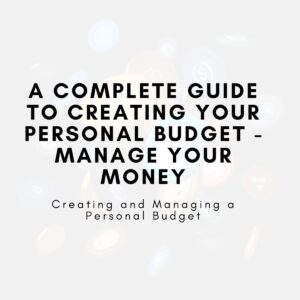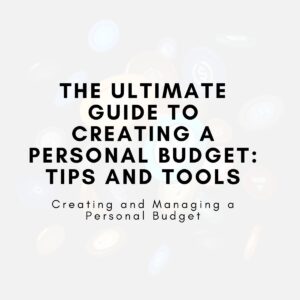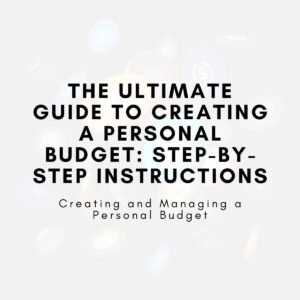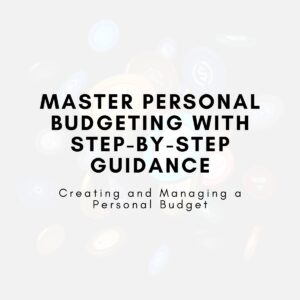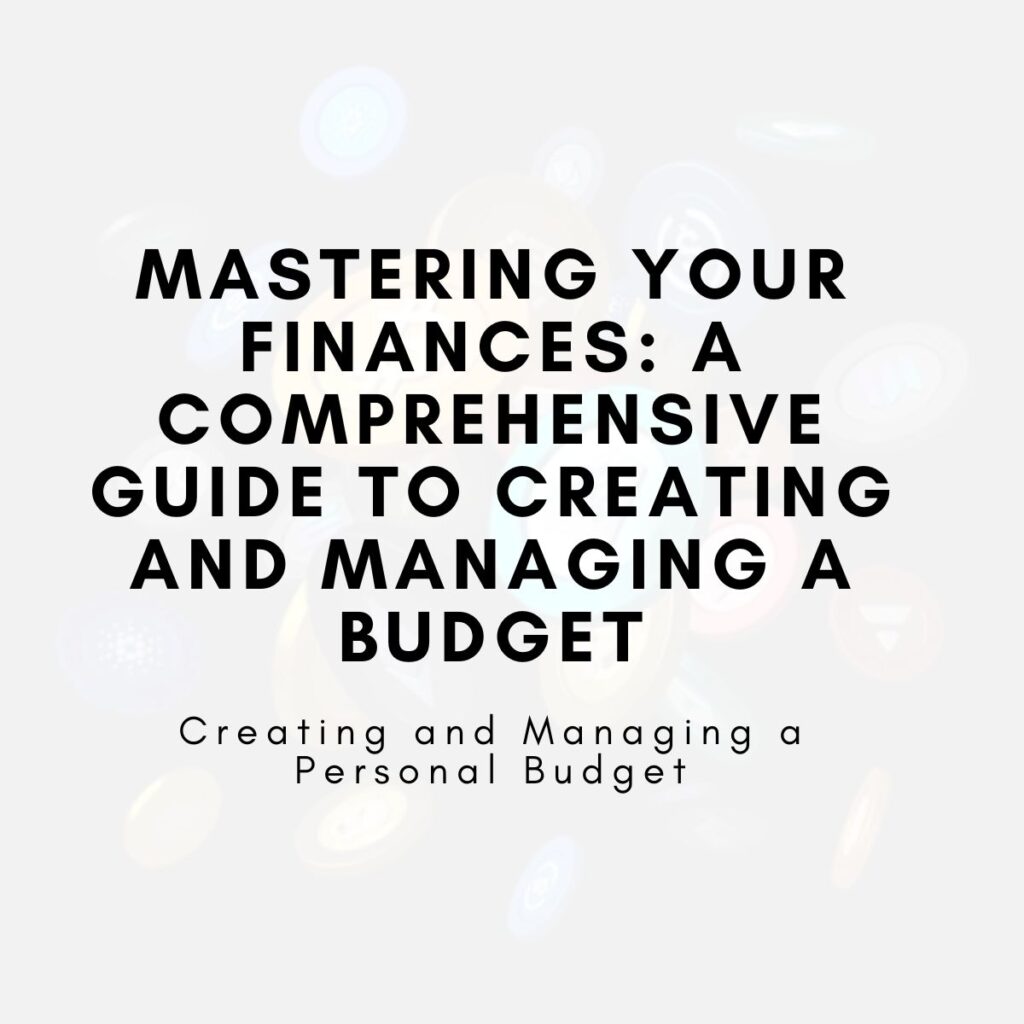
How can you master your finances by creating and managing a budget?
Mastering your finances starts with creating and managing a solid budget. This comprehensive guide will help you understand how to budget effectively, track your spending, and achieve your financial goals. By taking control of your finances with a well-thought-out budget, you can ensure a secure financial future.
Introduction
Mastering your finances is essential for achieving financial security and building a stable future. One of the most effective ways to take control of your finances is by creating and managing a personal budget. Whether you’re saving for a major purchase, trying to pay off debt, or simply want to better understand your spending habits, a budget serves as a roadmap to achieving your financial goals. The challenge lies not only in creating a budget, but also in sticking to it and making adjustments as needed. In this guide, we’ll walk you through the process of creating a budget, provide different budgeting methods to choose from, and give you tips for managing your finances effectively. By the end, you’ll be equipped with the tools and knowledge to manage your money with confidence and master your finances.
Why Creating and Managing a Budget is Crucial?
Get a Clear Picture of Your Financial Health
Creating a budget helps you see where your money is going and understand your financial health. For example, if you’re earning $4,500 a month and spending $2,000 on rent, $600 on groceries, $500 on transportation, and $700 on entertainment, you can clearly see that most of your income is being spent on fixed and discretionary expenses. By tracking this, you might realize that cutting back on entertainment (say, reducing dining out by $200) could allow you to save or pay off debt more effectively.
Work Towards Your Financial Goals
Setting specific financial goals helps you track your progress. For instance, if you want to save for a vacation, and the cost of the trip is estimated at $3,000, you can break this down into manageable monthly savings. If you aim to save $500 per month, you’ll be able to plan and see your progress. By tracking your savings goal in your budget, you can monitor whether you’re on track or need to adjust your spending to hit your target.
Prevent Overspending
Budgeting helps prevent overspending by allocating money to each spending category. Let’s say you’ve set a limit of $300 for groceries each month. When you notice that you’ve already spent $250 with a week left, you’ll realize you need to reduce spending or find more cost-effective alternatives. For instance, switching to bulk-buying or shopping at a different store can help you stay within your budget.
Steps to Creating and Managing Your Budget
Identify Your Income Sources
The first step in creating a budget is knowing exactly how much money you’re bringing in. For example, if you have a full-time job earning $3,000 per month, and you also work part-time, earning $800 per month, your total monthly income is $3,800. Understanding your total income gives you the framework to plan your spending, ensuring that your budget doesn’t exceed what you can afford.
Track and Categorize Your Expenses
Next, track all your expenses and categorize them into fixed and variable expenses. For example, fixed expenses could include $1,500 for rent and $100 for car insurance. Variable expenses might be $300 for groceries and $100 for entertainment. By categorizing these, you can identify patterns. If you see that you’re spending more on dining out than you’d like, you can decide to cook at home more often, helping you save money.
Set Financial Goals
Setting clear financial goals ensures you have something to strive towards. For instance, if you want to pay off a $10,000 credit card debt in one year, you could budget to pay off $850 each month. This amount is specific and measurable, and by tracking this goal, you can easily adjust your budget if needed.
Popular Budgeting Methods to Choose From
The 50/30/20 Rule
The 50/30/20 rule divides your income into three categories: 50% for needs, 30% for wants, and 20% for savings and debt repayment. For example, if you earn $4,000 a month:
- 50% (needs): $2,000 for rent, utilities, insurance, and groceries
- 30% (wants): $1,200 for entertainment, dining out, and shopping
- 20% (savings): $800 for emergency savings or retirement
This method is simple and flexible, ensuring that essential expenses are covered first, while also allowing room for discretionary spending and saving.
The Zero-Based Budget
With the zero-based budget, you allocate every dollar of your income to specific expenses or savings, leaving no money unaccounted for. For example, if your total income is $3,500, your budget might look like this:
- Rent: $1,200
- Groceries: $300
- Utilities: $150
- Savings: $500
- Debt Repayment: $600
- Entertainment: $250
- Miscellaneous: $200
By assigning every dollar, you ensure that all of your income is accounted for, either as an expense or as savings/debt repayment.
The Envelope System
This system involves using cash for each category and storing it in different envelopes. For example:
- $100 for groceries in the “Groceries” envelope
- $50 for entertainment in the “Entertainment” envelope
- $200 for transportation in the “Transportation” envelope
When the envelope is empty, you stop spending in that category. This method encourages discipline and helps prevent overspending in discretionary areas.
Tips for Sticking to Your Budget
Automate Your Savings
One of the easiest ways to stick to your budget is by automating your savings. For example, if you want to save $300 per month for an emergency fund, you can set up an automatic transfer of $300 from your checking account to a savings account right after each paycheck. This way, you won’t forget to save, and it becomes a fixed part of your budget.
Monitor and Adjust Your Budget Regularly
Review your budget at least once a month. For instance, if you receive a bonus, you can adjust your budget to increase your savings or pay off debt faster. Alternatively, if you unexpectedly spend more on utilities due to seasonal changes, you can adjust other categories to ensure you don’t go over budget.
Avoid Lifestyle Inflation
Lifestyle inflation happens when you increase your spending as your income rises. For example, if you get a raise, avoid upgrading your car or moving to a more expensive apartment. Instead, try to increase your savings or pay off more debt. By not inflating your lifestyle, you’ll free up more money for long-term financial goals.
Using Technology to Manage Your Budget
Budgeting Apps
Using budgeting apps like Mint or YNAB can make tracking your finances easier. For example, Mint automatically syncs with your bank accounts and credit cards, categorizing your expenses and giving you insights on your spending habits. This real-time tracking helps you stay on top of your budget without manually entering every expense.
Spreadsheets and Templates
For those who prefer a DIY approach, spreadsheets offer complete customization. You can create a personalized budget tracker that suits your unique needs. For example, using Google Sheets, you could create columns for income, fixed expenses, variable expenses, and savings. Then, you can use formulas to track totals, ensuring that your budget is always up to date.
Bill Payment Automation
Automating bill payments is a great way to stay organized and avoid late fees. For example, setting up automatic payments for your utilities, rent, and credit cards ensures you never miss a due date. This consistency allows you to manage your money without having to worry about deadlines.
Conclusion
Mastering your finances through budgeting is one of the most empowering steps you can take toward financial security. By understanding your income and expenses, setting clear goals, and choosing the right budgeting method, you can create a plan that works for you. Remember, budgeting isn’t about restricting your lifestyle—it’s about making intentional choices to achieve your financial goals. Stick to your budget, adjust when needed, and celebrate your financial progress along the way. With discipline and the right strategies, you’ll be well on your way to mastering your finances.
Key Takeaways
- Budgeting helps you understand your financial health and manage your expenses effectively.
- Choose a budgeting method that fits your needs, such as the 50/30/20 rule, zero-based budgeting, or the envelope system.
- Set specific financial goals to help guide your budget and stay motivated.
- Use technology, such as budgeting apps and spreadsheets, to simplify tracking and managing your budget.
- Automate savings and bill payments to ensure consistency in your financial plan.
- Regularly review and adjust your budget to accommodate changes in income or expenses.

